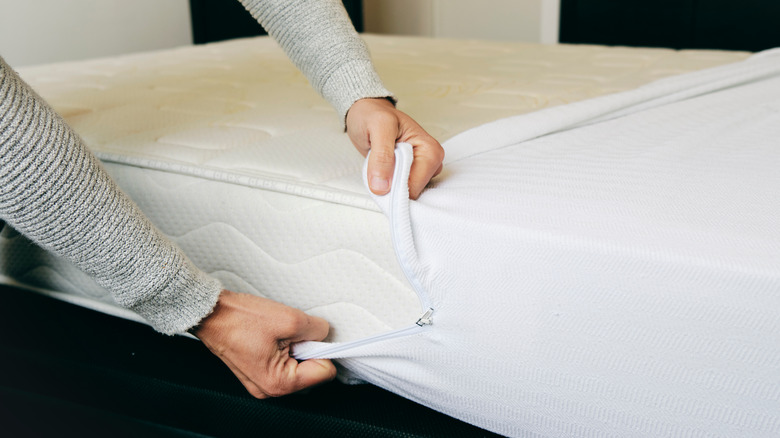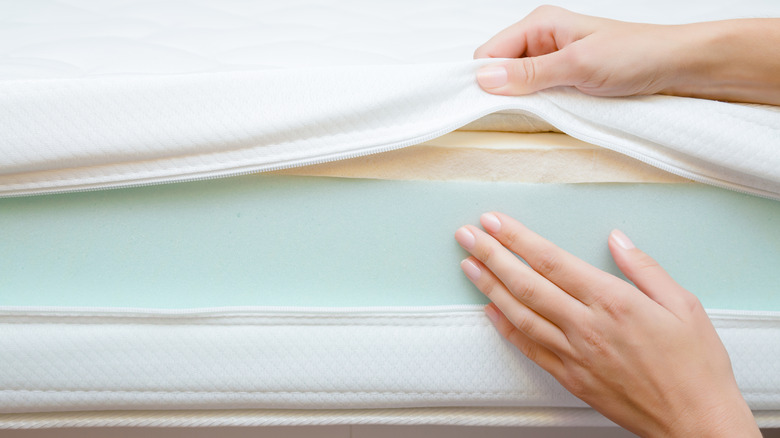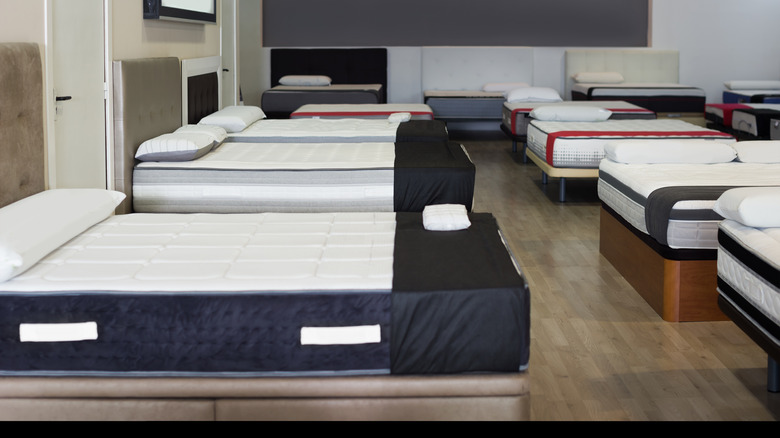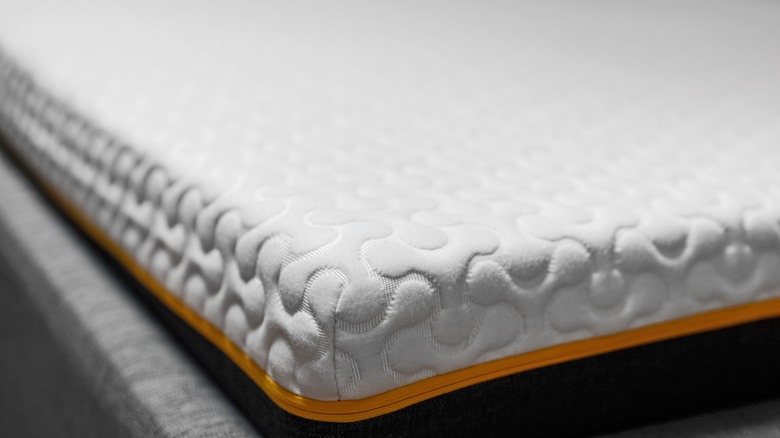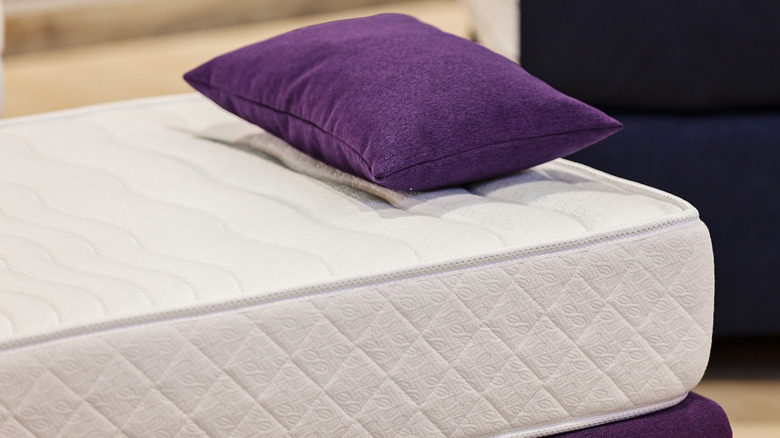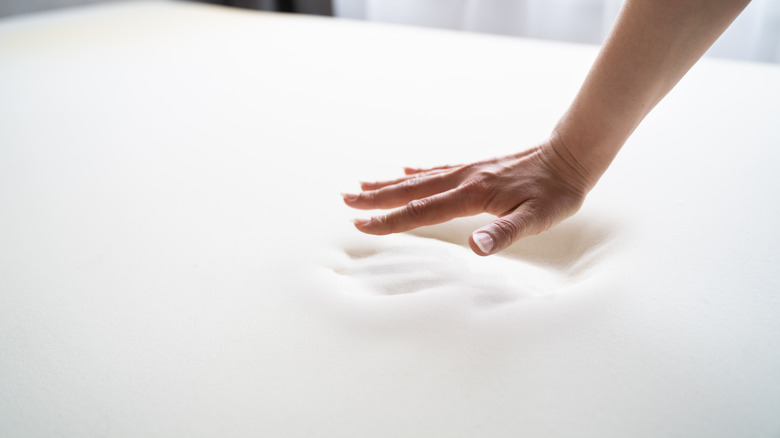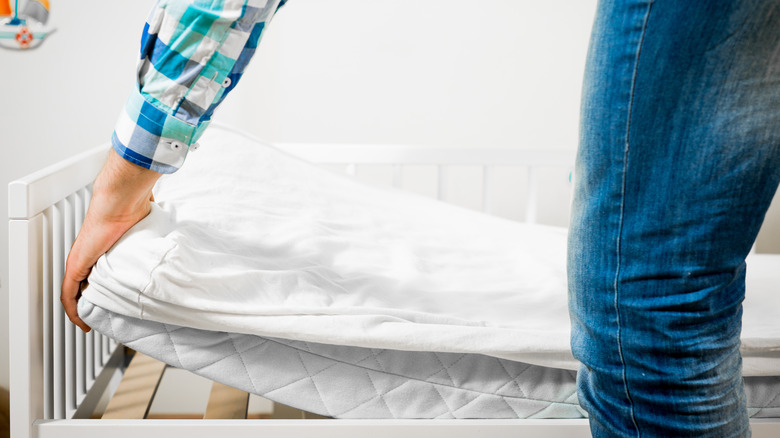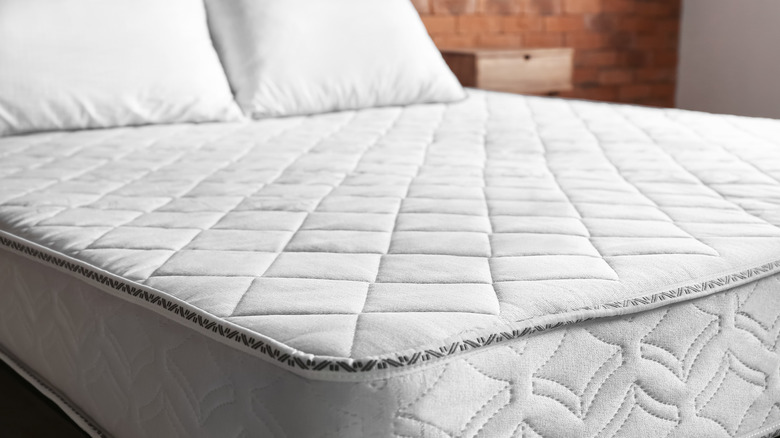Spring Mattress Vs. Memory Foam Mattress: What's The Difference?
While it may seem like a simple enough task, buying a new mattress can be an overwhelming and difficult choice to make. Choosing the ideal size may be simple enough, but other details such as firmness, material, and makeup can be more difficult to discern. In general, you should be replacing your mattress every six to eight years, recommends Sleep Foundation. Time isn't the only factor involved in the quality of a mattress, though. If you're waking up sore or groggy, your mattress is denting, your allergies are acting up, or there are rips, stains, or other sources of damage, it may be time to start looking for a new mattress.
Not only will a new mattress help you sleep better, but it can also prevent simple problems, like a sore neck or back, from turning into something more serious, or simple allergies from turning into an asthma attack. So, what are the differences between mattress types? Each mattress has its own individual characteristics in terms of thickness, size, material, and firmness. However, one of the main factors you should take into consideration is whether you want a spring or memory foam mattress.
How does the composition differ?
When it comes to memory foam mattresses versus spring mattresses, the biggest difference isn't necessarily visible. Rather, the major difference lies in the makeup and composition of the product. As the names would suggest, spring mattresses have internal springs built into the body, whereas memory foam mattresses are made entirely of foam. Memory foam consists of a viscoelastic, or low-resistance, polyurethane that reacts to pressure, heat, and transfer of energy to contort to your body shape, only returning to its original shape once the weight is completely gone. While spring mattresses, on the other hand, bounce back once you shift or take your weight off, explains Sleep Foundation.
Spring mattresses, have compressed metal coils inside that help provide comfort and thickness without being dented or misshapen. According to Slumber Search, older spring mattresses have interconnecting springs all within one frame, which can cause some discomfort, especially as the mattress gets older and more worn. New models, however, have individual pocket coils, which allow for the pressure to be tailored to your weight distribution and movement. Many new coil mattresses are designed to offer the best of both worlds and have memory foam padding on top.
What are the differences in cost?
The price of both spring and memory foam mattresses is quite variable. Factors like size, material, thickness, quality, and brand all have a major impact on the overall price. That being said, memory foam technology is a lot more advanced than springs, making memory foam a little pricier overall. A basic spring mattress can start as low as $150. Mid-grade models can cost around $700 for a Queen size, notes Mattress Firm, while luxury spring mattresses have a much steeper price point, with a king-size option costing nearly $1,400.
Memory foam mattresses have a range of prices, too, but start out a little more expensive. A basic full-size memory foam mattress costs around $260, whereas better-quality options will increase to well over $1000. High-end memory foam mattresses tend to be a hybrid with individual or dual coils and can cost $2,800 or more, according to the bedding retailer, Casper.
What are the differences in odor?
The way the mattress smells is likely not an obvious concern, and if you're shopping for a spring mattress, it shouldn't be. Foam mattresses, however, have been known to give off a pungent, gas-like scent. IKEA mattresses, for example, have been notorious for the unwelcome odor associated with them, warns Budget Friendly Furnishing.
While this isn't the case for every memory foam mattress, they tend to have a very chemical smell straight out of the packaging. This is due to the volatile organic compounds, or VOCs, that are found in the polyurethane used to make memory foam. Sleep Foundation notes that all memory foam mattresses have VOCs, but they become odiferous when exposed to air. Even so-called green mattresses have VOCs, although they tend to have less, and in turn, produce less of a smell. The smell can cause temporary irritations of the eyes, nose, and throat, so, if you can, try opening the mattress in a room with the window open or with a fan to allow it to air out. Thankfully, the smell tends to go away in a few hours or a few days at the most.
Pros and cons of spring mattresses
When deciding which mattress is right for you, you should carefully consider the advantages and disadvantages of each model and weigh them out with your preferences. Neither is perfect, but one may be better for you personally. One major benefit of spring mattresses is maneuverability. As Furniture Fair points out, spring mattresses don't move with your body the way memory foam does. This makes moving around your bed a lot easier. Spring mattresses are also better for people who sleep on their back and they tend to be cooler than memory foam mattresses in summer (though cooling gel foam does exist).
Spring mattresses aren't without their faults, though. For one, they are made of multiple metal coils, and while modern models are much more durable, they still can break. A broken coil can be a major pain to sleep on, and you'll probably need to replace the mattress altogether. They also aren't as plush as memory foam and can be a bit stiff.
Pros and cons of memory foam mattresses
Memory foam mattresses have their own unique set of advantages and disadvantages, too. For one, many people find memory foam to be more comfortable, especially those who enjoy lower levels of firmness. According to Nature's Sleep, memory foam can help support people with joint pain as the mattress responds to your body weight and heat. They're also great for people with respiratory issues, both in terms of being dust-resistant and for providing easier breathing during sleep. Finally, memory foam doesn't need to be flipped or turned.
As for cons, memory foam mattresses tend to be pricier, even for lower-quality ones. They also tend to retain heat as it absorbs from your body, which can be uncomfortable for some. For those who prefer super firm sleeping conditions, memory foam mattresses can sometimes feel a little softer than they'd like in terms of support, making them a poor choice for those with back problems.
Durability and maintenance
Mattresses aren't built to last forever, but knowing how to properly take care of and maintain your mattress can keep it serviceable for longer. According to Sleep Foundation, spring mattresses only tend to last six years on average, whereas memory foam mattresses can last up to seven years. The best way to extend the longevity of your mattress is to regularly turn, flip, and clean it. Rotating your mattress helps it to wear evenly as opposed to in just one area. It is recommended that both spring and memory foam mattresses be rotated one to two times per year, notes Sleep Foundation. A good indicator is if you notice your bed is sagging in one particular spot.
Cleaning your mattress a few times a year can also significantly help increase its lifespan. Changing your sheets weekly will help, but once every six months you should deep clean your mattress. Today recommends doing so by spraying the mattress lightly with white vinegar. Once it's completely dry, sprinkle some baking soda on top and let it sit for a while to absorb into the surface. Vacuum up the baking powder and make your bed, as normal.
Recommended use of each
When it comes to choosing between a spring or memory foam mattress, there is no right or wrong answer. With newer models made to be as comfortable and long-lasting as possible, the quality difference is pretty minimal. One great way to decide which one is right for you is by determining how you sleep. Furniture Fair states that back sleepers will tend to prefer spring mattresses, which offer a bit more support for the lower back, whereas side sleepers will likely enjoy the way memory foam mattresses contour to their body, and the same can be applied to people with joint issues.
Memory foam mattresses tend to be hotter, although there are plenty of cooling gel foam mattresses on the market. If you are particularly sensitive to smells, memory foam mattresses may not be the best choice, however, if you have allergies, especially to dust, a high-quality, hypoallergenic memory foam mattress is likely one of the best options.
